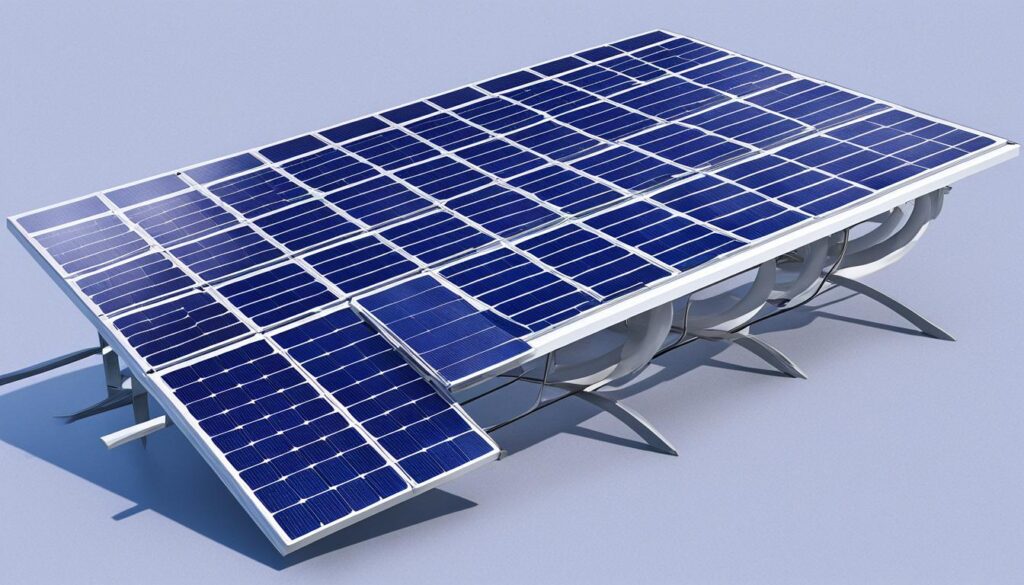
As a professional in the field of solar energy technology, I have witnessed firsthand the remarkable history and evolution of this sustainable power source. In this article, I will provide you with a comprehensive overview of the journey that solar energy technology has taken, highlighting its significant milestones and advancements. To illustrate the real-world impact of solar installation, we will explore a compelling case study of a small business that has implemented this cost-saving solution.
From its early origins to the integration of solar energy into the grid, the growth of this industry has been driven by continuous innovation and a commitment to cleaner, more efficient energy alternatives. As we delve into the topic, you will discover the environmental and economic benefits of solar energy, as well as the exciting possibilities that lie ahead for this renewable resource.
Key Takeaways:
- Solar energy technology has a rich history and has evolved significantly over the years.
- Early civilizations used solar heating techniques, and the development of solar power began in the 19th century.
- Important milestones include the invention of solar panels, advancements in efficiency, and the integration of solar energy into the grid.
- Solar energy offers environmental benefits, such as reduced carbon emissions and energy independence, while also creating job opportunities.
- The future of solar energy looks promising with ongoing advancements and increased adoption.
The Early Origins of Solar Energy Technology
Solar energy technology has ancient roots, with early civilizations harnessing the power of the sun for various purposes.
Solar heating techniques were utilized by these early societies to warm their homes and water, providing them with comfort and convenience.
The development of solar power as we know it today began in the 19th century with the discovery of photovoltaic cells. These cells have the remarkable ability to convert sunlight into electricity, opening up a whole new realm of possibilities for solar energy technology.
“The discovery of photovoltaic cells was a groundbreaking moment in human history, as it paved the way for the generation of electricity directly from the sun’s abundant energy.” – Thomas Edison
With the advent of photovoltaic cells, the foundation was laid for the development of solar panels and the widespread adoption of solar power as an efficient and sustainable energy source.
Early Solar Technology: A Timeline
| Time Period | Key Developments |
|---|---|
| Ancient Times | Solar heating techniques used by civilizations such as the Greeks and Romans |
| 1839 | Edmund Becquerel’s discovery of the photovoltaic effect |
| 1883 | Charles Fritts constructs the first solar cell using selenium |
| 1954 | Bell Laboratories creates the first modern silicon solar cell |
This timeline highlights the key milestones in the early development of solar energy technology, showcasing its evolution from ancient solar heating techniques to the breakthrough discovery of photovoltaic cells.
Stay tuned for the next section where we explore further milestones in the history of solar energy technology.
Solar Energy Case Study: A Small Business Success Story
To illustrate the real-world impact of solar energy adoption, let’s examine the case study of GreenLeaf Café, a small business that decided to invest in solar energy to reduce operating costs and promote sustainability.
Background: GreenLeaf Café, located in a bustling urban area, was struggling with rising electricity costs and sought ways to minimize its environmental footprint. The owners recognized that by investing in solar panels, they could achieve both financial savings and contribute to a greener community.
Implementation: In 2021, GreenLeaf Café partnered with a local solar energy provider to install a solar array on the rooftop. The project involved a thorough energy audit to determine the optimal size of the solar system based on the café’s energy consumption. After evaluating various financing options, they opted for a Power Purchase Agreement (PPA), allowing them to install the solar panels with no upfront costs. Under the PPA, GreenLeaf Café agreed to purchase the electricity generated by the solar panels at a fixed rate for the next 20 years.
Results: After the installation, GreenLeaf Café experienced a 50% reduction in electricity bills, translating to substantial annual savings. Additionally, the solar system generates enough energy to cover approximately 80% of their electricity needs. The café proudly displays its solar panels, attracting environmentally conscious customers who appreciate the commitment to sustainability.
Moreover, the switch to solar has allowed GreenLeaf Café to market itself as a green business, enhancing its brand image and increasing foot traffic. The owners reported a 20% increase in customer engagement due to their eco-friendly initiatives, further boosting sales.
Conclusion: This case study of GreenLeaf Café exemplifies how small businesses can harness solar energy to reduce costs, enhance their sustainability efforts, and attract new customers. As solar technology continues to evolve and become more accessible, similar success stories will likely emerge, demonstrating the transformative potential of solar energy in the business sector.
Milestones in Solar Energy Technology
Throughout history, several significant milestones have shaped the development and growth of solar energy technology. These milestones include the invention of the first solar panels in the 1950s, the development of solar thermal systems for heating and electricity generation, and the recent expansion of the solar industry.
In the 1950s, researchers at Bell Labs introduced the world to the first practical solar panels. These panels, made of silicon, were a breakthrough in harnessing sunlight and converting it into electricity. Although they were relatively inefficient compared to modern standards, they laid the foundation for further advancements in solar technology.
Solar thermal systems also played a crucial role in the evolution of solar energy. These systems use the sun’s heat to generate electricity or provide heating for buildings. One notable milestone was the development of concentrated solar power (CSP) plants, which use mirrors or lenses to focus sunlight onto a small area, producing high temperatures to generate electricity. CSP has proven to be an effective method of harnessing solar energy on a large scale.
“The growth of the solar industry in recent years has been remarkable, driven by technological advancements and increased demand for clean, renewable energy.”
Moreover, the solar industry has experienced significant growth in recent years. The increased awareness of climate change and the need for sustainable energy sources have propelled solar energy to the forefront. Governments and businesses worldwide have recognized the economic and environmental benefits of solar power, leading to substantial investments in solar installations.
According to the International Energy Agency (IEA), the solar industry has been one of the fastest-growing energy sectors in the world, with an average annual growth rate of 40% over the past decade. In 2020 alone, the global installed solar capacity surpassed 700 gigawatts, marking a major milestone in the industry’s expansion.
This chart illustrates the global solar industry growth in installed capacity:

The rapid growth of the solar industry has not only led to a significant reduction in carbon emissions but has also created job opportunities. In the United States alone, the solar industry employed over 230,000 workers in 2020, contributing to the economy while driving the transition to a clean energy future.
Advancements in Solar Panel Efficiency and Cost
Over time, advancements in manufacturing techniques and materials have significantly improved solar panel efficiency while reducing costs. These developments have played a crucial role in making solar energy a more viable and accessible option for businesses and homeowners.
One of the key factors in improving solar panel efficiency is the continuous innovation in photovoltaic technology. One notable breakthrough is the use of thin-film solar cells. These cells are much thinner and more flexible compared to traditional crystalline silicon cells, allowing for easier integration into various applications. Thin-film solar cells have shown promising results in terms of energy production, even in low-light conditions, making them particularly suitable for certain environments.
The use of thin-film solar cells has contributed to enhancing the performance of solar panels, allowing for improved energy capture and conversion.
Furthermore, advancements in material science have led to the development of solar panels that are more durable and efficient in converting sunlight into electricity. Through the use of cutting-edge materials, researchers have achieved higher conversion rates, increasing the overall performance and output of solar panels.
The reduction in the cost of solar panels can be attributed to economies of scale, increased competition among manufacturers, and government incentives. As the demand for solar energy has grown, manufacturing processes have become more streamlined, leading to cost savings in production. Additionally, the competition among solar panel manufacturers has driven prices down, making solar energy a more affordable option for consumers.
Government incentives, such as tax credits and grants, have also played a significant role in reducing the cost of solar installation. These incentives encourage businesses and homeowners to adopt solar energy systems by offsetting a portion of the upfront costs. As a result, more people have been able to take advantage of the financial benefits that solar energy offers.
The combination of improved efficiency and reduced costs has made solar energy an increasingly attractive option for both economic and environmental reasons. As advancements in solar panel technology continue to drive efficiency gains and cost reductions, the future of solar energy looks brighter than ever.

Integration of Solar Energy into the Grid
As solar energy continues to gain popularity and become a mainstream source of power, it is crucial to ensure its seamless integration into the existing electrical grid. This is where grid integration plays a significant role. By efficiently connecting solar energy systems to the grid, we can maximize the benefits of renewable energy while maintaining a reliable and stable power supply.
One key element of grid integration is net metering. Net metering programs enable solar system owners to feed excess electricity they generate back into the grid. In return, they receive credits or monetary compensation for the electricity they provide. This not only encourages individuals and businesses to invest in solar energy but also facilitates a smooth two-way flow of power between the grid and solar installations.
Another important aspect of grid integration is the development of solar storage solutions. Solar energy is intermittent, meaning it is generated only when the sun is shining. However, by incorporating storage systems, such as batteries, we can capture and store excess solar energy for use during periods of low or no sunlight. This improves the reliability and flexibility of solar energy, allowing it to contribute to a more stable grid.
Furthermore, smart grid technology plays a crucial role in the effective integration of solar energy. A smart grid utilizes advanced communication and automation systems to monitor, control, and optimize the generation, distribution, and consumption of electricity. By leveraging real-time data and intelligent algorithms, the smart grid can manage the fluctuating supply and demand of solar energy, ensuring efficient utilization and minimizing wastage.
Grid integration is essential for a successful transition to a renewable energy future. It enables us to harness the full potential of solar energy while maintaining a reliable and resilient electrical grid. Implementing net metering programs, developing storage solutions, and utilizing smart grid technology are key steps toward achieving a sustainable and efficient energy system.
Overall, achieving effective grid integration is instrumental in unlocking the full potential of solar energy. Through net metering, solar storage, and smart grid technology, we can create a harmonious relationship between solar installations and the electrical grid. This synergy not only facilitates the transition to a cleaner energy future but also ensures a stable and reliable power supply for all.
| Grid Integration Benefits | Net Metering Programs | Solar Storage Solutions | Smart Grid Technology |
|---|---|---|---|
| Enhanced renewable energy utilization | Empowers solar system owners | Improves reliability and flexibility | Optimizes energy distribution |
| Stable and reliable power supply | Facilitates two-way flow of power | Utilizes excess solar energy | Enables real-time monitoring and control |
| Efficient utilization of solar energy | Incentivizes investment in solar | Minimizes wastage of solar energy | Optimizes supply-demand balance |
Innovations in Solar Energy Applications
The evolution of solar energy technology has sparked innovations in various applications, expanding its reach and impact. These advancements have paved the way for the development of solar-powered devices, the establishment of large-scale solar farms, and the exploration of solar-powered transportation options.
Solar-Powered Devices
Solar energy has empowered the creation of innovative devices that harness the sun’s energy to perform various functions. From portable chargers for electronic devices to solar-powered lights and water heaters, these devices offer sustainable alternatives to traditional energy sources.
Imagine a world where your smartphone battery never dies and your outdoor adventures are illuminated by solar-powered lanterns. With solar-powered devices becoming increasingly efficient, reliable, and affordable, this vision is becoming a reality.
Solar Farms for Electricity Generation
The establishment of solar farms, also known as photovoltaic power stations, has revolutionized electricity generation. These vast expanses of solar panels capture sunlight and convert it into clean, renewable energy on a large scale. Solar farms are capable of powering entire communities, reducing reliance on traditional fossil fuel-based power plants.
Solar farms not only contribute to a greener and more sustainable future but also create local job opportunities during construction and maintenance. Additionally, the utilization of solar farms helps reduce carbon emissions, mitigating the impact of climate change.
Solar-Powered Transportation
The transportation sector is also embracing solar energy for sustainable mobility solutions. Solar-powered transportation includes vehicles and infrastructure designed to harness solar power as an alternative fuel source.
Electric vehicles (EVs) equipped with solar panels on their roofs can generate electricity to power the vehicle or provide supplementary energy to extend their range. Additionally, solar-powered charging stations allow EV owners to recharge their vehicles using renewable energy.
Driving towards a greener future, solar-powered transportation offers a sustainable and cost-efficient solution. As solar technology continues to advance, we can expect to see increased adoption of solar-powered vehicles and infrastructure worldwide.
The Future of Solar Energy Applications
The innovations in solar energy applications demonstrate the versatility and potential of this renewable energy source. From powering individual devices to generating electricity on a large scale and revolutionizing transportation, solar energy unlocks endless possibilities for a sustainable and clean future.
| Solar-Powered Devices | Solar Farms | Solar-Powered Transportation |
|---|---|---|
| Portable solar chargers | Photovoltaic power stations | Solar-powered electric vehicles |
| Solar-powered lights | Community-scale solar installations | Solar-powered charging stations |
| Solar water heaters | Job creation | Solar-powered public transport |
Environmental and Economic Benefits of Solar Energy
Solar energy is a key player in the transition to a more sustainable future, offering significant environmental and economic advantages. As a renewable energy source, solar power plays a crucial role in reducing carbon emissions and combating climate change. Its operation produces no harmful greenhouse gases, making it a cleaner alternative to traditional forms of energy generation.
One of the most compelling benefits of solar energy is its potential to contribute to energy independence. By harnessing the power of the sun, individuals, businesses, and communities can generate their own electricity, reducing reliance on fossil fuel-based grids. This independence empowers users to take control of their energy consumption, resulting in greater stability and resilience.
Additionally, the adoption of solar energy has substantial economic implications. The growth of the solar industry creates new job opportunities, leading to job creation and economic development. From solar panel manufacturing to installation and maintenance, the renewable energy sector drives employment across various skill levels and disciplines.
“Solar energy has the potential to transform our economy, creating millions of jobs and reducing our dependence on foreign oil.” – Barack Obama
The chart below highlights the job creation potential of the solar industry:
| Type of Job | Number of Jobs |
|---|---|
| Solar Installation Technicians | 120,000+ |
| Solar Panel Manufacturing | 35,000+ |
| Solar Project Developers | 50,000+ |
| Solar Sales and Marketing | 25,000+ |
The solar industry not only supports job creation but also offers significant economic benefits to communities. Local economies benefit from increased revenue, tax incentives, and reduced energy costs. Furthermore, businesses and homeowners who invest in solar power can save on their electricity bills in the long run, providing financial relief and stability.
In summary, solar energy presents a sustainable solution to address the challenges of carbon emissions, energy independence, and job creation. By harnessing the power of the sun, we can create a cleaner and more prosperous future.
Conclusion
In summary, the history and evolution of solar energy technology have paved the way for its widespread adoption as a clean and sustainable energy source. The continuous advancements in efficiency, cost reduction, grid integration, and applications indicate a promising future for solar energy.
As more businesses, like the one in our case study, embrace solar installation, the benefits of this technology will continue to grow. Solar energy offers a viable solution to reduce carbon emissions and achieve energy independence. It not only contributes to a cleaner environment but also creates job opportunities in the growing solar industry.
The future of solar energy looks bright, with ongoing research and development aiming to further enhance efficiency and reduce costs. As technology continues to improve, we can expect to see even more innovative applications of solar energy, ranging from solar-powered devices to large-scale solar farms. Investing in solar energy now not only makes financial sense but also contributes to a sustainable future for generations to come.
FAQ
What is the history of solar energy technology?
Solar energy technology has ancient roots, with early civilizations using solar heating techniques to warm their homes and water. The development of solar power as we know it today began in the 19th century with the discovery of photovoltaic cells, which convert sunlight into electricity.
What are the significant milestones in solar energy technology?
Significant milestones in solar energy technology include the invention of the first solar panels in the 1950s, the development of solar thermal systems for heating and electricity generation, and the growth of the solar industry in recent years.
How have advancements in solar panel efficiency and cost reduction impacted solar energy?
Over time, advancements in manufacturing techniques and materials have led to increased solar panel efficiency and reduced costs. Improvements in photovoltaic technology, such as the use of thin-film solar cells, have contributed to making solar energy more affordable and accessible.
How is solar energy being integrated into the existing electrical grid?
Efforts have been made to integrate solar energy into the existing electrical grid, including the implementation of net metering programs, the development of solar storage solutions, and the use of smart grid technology to optimize energy distribution.
What are some innovations in solar energy applications?
Innovations in solar energy applications include the development of solar-powered devices, the establishment of large-scale solar farms for electricity generation, and the exploration of solar-powered transportation options.
What are the environmental and economic benefits of solar energy?
Solar energy offers numerous environmental and economic benefits. It is a renewable energy source that produces no carbon emissions during operation, contributes to energy independence, and creates job opportunities in the growing solar industry.
Source Links
- https://interplasinsights.com/plastics-industry-news/Plastic-industry-events-conferences-news/lehvoss to-present-flame-retardant-solutions-in-transportati/
- https://nptelegraph.com/news/nation-world/new-details-in-drone-that-killed-us-troops-former-mlb-manager-jimy-williams-dies-record/article_a11cb7fd-48c5-59a3-a5cf-0845f628f2f3.html
- https://www.altenergymag.com/article/2024/01/navigating-the-twin-transition-the-crucial-role-of-isvs-in-digitalization-and-sustainability-/41015/








